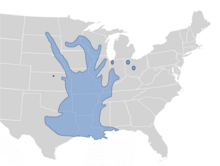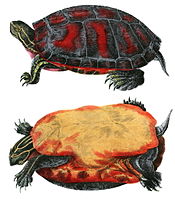False map turtle
| False map turtle | |
|---|---|

| |
| Scientific classification | |
| Domain: | Eukaryota |
| Kingdom: | Animalia |
| Phylum: | Chordata |
| Class: | Reptilia |
| Order: | Testudines |
| Suborder: | Cryptodira |
| Superfamily: | Testudinoidea |
| Family: | Emydidae |
| Genus: | Graptemys |
| Species: | G. pseudogeographica
|
| Binomial name | |
| Graptemys pseudogeographica (Gray, 1831)
| |
| Subspecies | |
| |

| |
| Range map | |
| Synonyms | |
| |
The false map turtle (Graptemys pseudogeographica) is a species of turtle endemic to the United States. It is a commonly-kept pet species. Two subspecies are recognized—the nominate subspecies (G. pseudogeographica), described here, and the Mississippi map turtle (G. p. kohnii).
Description
Also known as a "sawback" turtle, the false map turtle's
Geographic range
The false map turtle's native range is primarily east of the Rocky Mountains, encompassing large tributaries and offshoots of the Missouri and Mississippi River systems.[4] Thus, the species may be found in the Midwest, from Ohio, Indiana, Illinois, Wisconsin, Missouri and Minnesota, north through the Dakotas and south through southwestern Alabama, southern and western Mississippi, and Louisiana.[4] The false map turtle also lives in several other river systems of Southwest Louisiana and East Texas.[4]
Due to the release of unwanted pet map turtles, likely by unqualified individuals, the species has also become established in areas outside of its natural range, including southwestern British Columbia, Canada (around Vancouver),[5] and the regions of Guanajuato, Mexico City and Nayarit, Mexico.[4] In the U.S., false map turtle sightings have been documented in the western states of California, Colorado, Nevada (near metro Las Vegas), Oregon and Washington.[4]
Conservation status
Overall, despite increasing encroachment by humans and potential changes to their natural habitats, the false map turtle is listed as "least concern" by the
Behavior
Map turtles of all kinds are avid baskers, spending many hours during the day in the sun. When with other turtles, they also are very communal, sharing space and using each other for predator-watching, increasing the odds of surviving an attack.
Subspecies
- Nominotypical subspecies: G. p. pseudogeographica (Gray, 1831) – False or northern false map turtle.
Ecology
The false map turtle is an adept swimmer and prefers to inhabit rivers and large creeks with moderate to semi-strong currents, containing aquatic vegetation, exposed boulders, snags or floating logs. They are most comfortable in deeper, fast-flowing, well-oxygenated waters (as opposed to other species, such as snapping turtles, which prefer darker, still—possibly stagnant—ponds). False map turtles are still present in oxbow lakes and sloughs, but are largely absent from lakes, ponds, or smaller streams. The sun and basking are very important to these turtles, and they prefer to live in areas with fewer trees or shade cover overhead; they may even be found sunning on steep, slippery snags.
Threats and management issues
A variety of threats face this species, including the destruction of nests of
In addition to some pet turtles potentially escaping and surviving in the wild, it is thought that many, many more are likely to be set free in local waterways by their unprepared owners, or the weary parents of children who have lose interest, rather than being re-homed or surrendered to a local humane society, turtle or reptile group (or even a pet store); this has inevitably lead to the false map turtle being sighted in areas well beyond its native range, such as Arizona, California and other states west of the Rockies.
Gallery
-
Clutch preparation of a breeding false map turtle on a meadow
-
Same turtle during oviposition
References
- . Retrieved 27 October 2022.
- ^ a b c Graptemys pseudogeographica, Reptile Database
- S2CID 87809001.
- ^ a b c d e "iNaturalist Observations". Retrieved 11 March 2024.
- ^ "iNaturalist Observations". Retrieved 11 March 2024.
Further reading
- ISBN 0-395-19977-8(paperback). (Graptemys pseudogeographica, pp. 57–58 + Plate 8 + Map 14.)
- Ernst, C.H., J.E. Lovich and R.W. Barbour. (1994). Turtles of the United States and Canada. Smithsonian Institution Press. Washington, District of Columbia.
- Gray, J.E. (1831). Synopsis Reptilium; or Short Descriptions of the Species of Reptiles. Part I.—Cataphracta. Tortoises, Crocodiles, and Enaliosaurians. Treuttel, Wurz, and Co. London. viii + 85 pp. + 11 plates. (Emys pseudogeographica, p. 31.)
- ISBN 0-307-13666-3(paperback). (Graptemys pseudogeographica, pp. 50–51.)
External links
- Graptemys pseudogeographica Archived 18 September 2016 at the Wayback Machine, Illinois Natural History Survey
- False Map Turtle, Reptiles and Amphibians of Iowa
- Graptemys pseudogeographica, The Reptile Database




